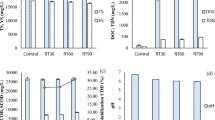Abstract
In this paper, rice straw was used as a raw material to produce biogas by anaerobic batch fermentation at 35 °C (mesophilic) or 55 °C (thermophilic). The hydrogen sulfide in biogas can be converted to S0 or sulfate and removed in-situ under micro-oxygen environment. Trace oxygen was conducted to the anaerobic fermentation tank in amount of 0.5, 1.0, 2.0, 3.0, 4.0, 5.0, or 10.0 times stoichiometric equivalence, respectively, and the control experiment without oxygen addition was carried out. The results showed that the initial H2S concentrations of biogas are about 3235 ± 185 mg/m3 (mesophilic) or 3394 ± 126 mg/m3 (thermophilic), respectively. The desulfurization efficiency is 72.3 % (mesophilic) or 65.6 % (thermophilic), respectively, with oxygen addition by stoichiometric relation. When the oxygen feeded in amount of 2∼4 times, theoretical quantity demanded the removal efficiency of hydrogen sulfide could be over 92 %, and the oxygen residue in biogas could be maintained less than 0.5 %, which fit the requirement of biogas used as vehicle fuel or combined to the grid. Though further more oxygen addition could promote the removal efficiency of hydrogen sulfide (about 93.6 %), the oxygen residue in biogas would be higher than the application limit concentration (0.5 %). Whether mesophilic or thermophilic fermentation with the extra addition of oxygen, there were no obvious changes in the gas production and methane concentration. In conclusion, in-situ desulfurization can be achieved in the anaerobic methane fermentation system under micro-oxygen environment. In addition, air could be used as a substitute oxygen resource on the situation without strict demand for the methane content of biogas.





Similar content being viewed by others
References
Yao, X. J., & Tian, Y. S. (2005). The clean techniques for the utilization of biomass energy. Beijing: Chemical Industry Press, 12, 116.
Zhang W, Li XJ, Pang Y Zh, Cai LP. A Pilot Study on Mesophilic Dry Anaerobic Digestion of Rice Str aw. Journal of Agro-environment Science 2008, (05), 2075–2079.
GB18047-2000 Compressed natural gas as vehicle fuel. The National Standard of the People’s Republic of China.
Dueblein, D.; Steinhauser, A., Biogas from waste and renewable resources. KGaA: Wiley-VCH Verlag GmbH and Co 2008.
Rasi, S., Läntelä, J., & Rintala, J. (2011). Trace compounds affecting biogas energy utilisation—a review. Energy Conversion and Management, 52(12), 3369–3375.
Wang, L. J., Zhang, X. M., Zhang, D., & WEI, G. D. (2011). Separation of high pure methane from biogas with hydrate method. China Biogas, 05, 34–37.
Song, C. H., Xiao, B., Shi, X. Y., & Yang, X. Y. (2007). Review on biogas upgrading technology. China Biogas, 04, 23–27.
Patterson, T., Esteves, S., Dinsdale, R., & Guwy, A. (2011). An evaluation of the policy and techno-economic factors affecting the potential for biogas upgrading for transport fuel use in the UK. Energy Policy, 39(3), 1806–1816.
Appels, L., Baeyens, J., Degrève, J., & Dewil, R. (2008). Principles and potential of the anaerobic digestion of waste-activated sludge. Progress in Energy and Combustion Science, 34(6), 755–781.
Rongwong, W., Boributh, S., Assabumrungrat, S., Laosiripojana, N., & Jiraratananon, R. (2012). Simultaneous absorption of CO2 and H2S from biogas by capillary membrane contactor. Journal of Membrane Science, 392, 38–47.
Syed, M., Soreanu, G., Falletta, P., & Béland, M. (2006). Removal of hydrogen sulfide from gas streams using biological processes—a review. Canadian Biosystems Engineering / Le Genie des Biosystems au Canada, 48, 2.1–2.14.
Weiland, P. (2010). Biogas production: current state and perspectives. Applied Microbiology and Biotechnology, 85(4), 849–860.
Hu MC, Long TR. New Developments in Hydrogen Sulfide Removing Bio-process from Biogas. China Biogas 2007, (02), 15–19.
Ramos, I., Perez, R., & Fdz-Polanco, M. (2013). Microaerobic desulphurisation unit: a new biological system for the removal of H2S from biogas. Bioresource Technology, 142, 633–640.
Díaz, I., Pérez, S. I., Ferrero, E. M., & Fdz-Polanco, M. (2011). Effect of oxygen dosing point and mixing on the microaerobic removal of hydrogen sulphide in sludge digesters. Bioresource Technology, 102(4), 3768–3775.
Fdz-Polanco, M., Diaz, I., Perez, S. I., et al. (2009). Hydrogen sulphide removal in the anaerobic digestion of sludge by micro-aerobic processes: pilot plant experience. Water Science and Technology, 60(12), 3045–3050.
Diaz, I., Lopes, A. C., Perez, S. I., et al. (2010). Performance evaluation of oxygen, air and nitrate for the microaerobic removal of hydrogen sulphide in biogas from sludge digestion. Bioresource Technology, 101(20), 7724–7730.
Ramos, I., Pérez, R., Reinoso, M., et al. (2014). Microaerobic digestion of sewage sludge on an industrial-pilot scale: The efficiency of biogas desulphurisation under different configurations and the impact of O2, on the microbial communities. Bioresource Technology, 164(7), 338–346.
Author information
Authors and Affiliations
Corresponding author
Rights and permissions
About this article
Cite this article
Wu, M., Zhang, Y., Ye, Y. et al. In situ Removal of Hydrogen Sulfide During Biogas Fermentation at Microaerobic Condition. Appl Biochem Biotechnol 180, 817–825 (2016). https://doi.org/10.1007/s12010-016-2135-3
Received:
Accepted:
Published:
Issue Date:
DOI: https://doi.org/10.1007/s12010-016-2135-3




